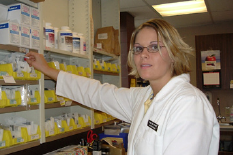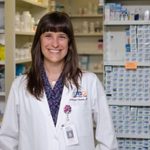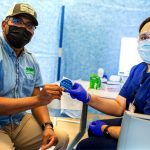Innovating the Pharmacy Technician’s Role
New Paradigm Frees Up Pharmacists for Direct Patient Care
AS PHARMACISTS EXPAND THEIR ROLES and carve out new niches in an era of health care reform, they are counting more and more on highly skilled pharmacy technicians to take on added responsibility.
Pharmacy technicians in practice sites around the country are performing tasks that were once considered solely the domain of pharmacists, such as dispensing medication, taking prescriptions over the phone, and managing error-reduction efforts. The result is tandem evolution: When pharmacy techs handle these duties, it frees pharmacists up to counsel patients and grow as key members of multidisciplinary health teams.
“Highly trained, skilled technicians are critical elements in a high-functioning pharmacy team,” said ASHP President Diane Ginsburg, M.S., R.Ph., FASHP. “If pharmacists are to achieve their highest calling—direct patient care—we must be able to rely on our technician workforce as our support system.”
In order for technicians to shoulder more responsibility, they will need more training and education. The push is on nationwide for standardization and accreditation.
“With the advancing role of pharmacists, we need technicians who are properly trained,” said Lisa S. Lifshin, R.Ph., director of program services and coordinator of technician program development in ASHP’s Accreditation Services Division. “Consumers are more in tune with their own safety, and they want someone who is trained to handle their medications safely.”
Portable, High-Level Skills

Heather Stremick, a student in the North Dakota State College of Science Pharmacy Technician Program in Wahpeton, checks the stock for a medication
The requirements for ASHP-accredited programs are stringent. Students must complete at least 600 hours of training and education that combine didactic components such as lectures and textbook learning, hands-on experience through lab work, and actual experiential rotations in real pharmacy environments.
The result of such an intensive mix of education is a thoroughly prepared pharmacy technician. This new type of worker has skills that are portable not just from environment to environment but also from region to region as more and more states ratchet up their standards and require pharmacy technicians to register with boards of pharmacy.
“We are a mobile society, and when techs train under accredited programs, there is an assurance that they have the same broad knowledge and training,” said Barbara Lacher, assistant program director and associate professor at the North Dakota State College of Science (NDSCS) Pharmacy Technician Program in Wahpeton. “They are not trained just to be a retail technician or a hospital technician. They have across-the-board training, and you know that anyone you hire out of an accredited program has had experience with things that nonaccredited programs might not offer, like vaccines, sterile products, IV preparation, and stress management.”
ASHP is not the only organization advocating for the professionalism of the pharmacy technician workforce. The National Association of Boards of Pharmacy, which has several technician training task forces, is advocating that technicians complete an education and training program that meets minimum standardized guidelines. It also recommends the use of a single accrediting agency
and a program that is developed by an established pharmacy organization.
Innovations in Pharmacy Tech Education
As the demand for highly trained pharmacy technicians grows, educators are using local resources creatively to offer comprehensive instruction to students. In Florida, Orange County Public Schools (OCPS) offers accredited pharmacy technician programs through technical schools such as Westside Tech in Orlando and Winter Park Techin Winter Park, where students range in age from 16 to about 40.

A pharmacy technician at Wishard Health Services, Indianapolis, utilizes the pharmacy’s electronic inventory.
“One of the toughest things [about setting up a program] was finding a way to educate full-time adult students and part-time high school students,” said Lori DeVeau-Diem, CPhT, a pharmacy technician instructor at Westside. “We had to juggle the schedule to ensure that the part-time students would get all of the necessary instruction and the full-time students wouldn’t have stretches of unoccupied time.”
The answer was to craft a modular program in which students can proceed at the pace that works best with their schedules and allows for one-on-one time with instructors as well as interaction with other students.
The heterogeneity of the student population benefits all involved, said John Diem, CPhT, director of pharmacy technician programs for OCPS. “Our students work extremely well together. The high school students challenge the adults academically, and the adults give them an example of professionalism and maturity,” he said. “It prepares them for working in the real world, where they’ll be working alongside people of all ages.”
At Southeastern Technical College, which has three campuses in southeastern Georgia, the pharmacy technician program stresses hands-on experience indifferent environments.
“My students do a lot of community service,” said Karen Davis, CPhT, pharmacy technology instructor at the Vidalia campus and former president of the Pharmacy Technician Educators Council. “They will work in patient assistant programs, do paperwork, conduct inventory, request medications, type labels, and more.”
Students in Southeastern’s program can rotate through different facilities as interns, where they learn how to be part of a multidisciplinary health team. “What students get in the classroom and lab should be reinforced at the work site,” said Davis. “By the time they have to take their tests for certification, they know how to do everything from data entry to IVs to total parenteral nutrition. The ASHP requirements are designed not for us to teach but for students to do.”
Looking Ahead
The future for pharmacy technicians is a bright one. The Bureau of Labor Statistics predicts that employment of pharmacy technicians will increase 31 percent by 2018 compared with 2008 figures, not only because pharmacists are expanding into more clinical roles, but also because prescription drug use will increase overall as the population ages.
The projected growth of programs is not just in hospital systems and traditional academia, said ASHP’s Lifshin. “We are getting a lot of calls from community and chain pharmacy representatives about how they can start an accredited program,” she said. “Health care is always a good avenue for schools to explore, and accreditation is their way of becoming more competitive. The voice of accreditation is a lot louder than it was just a few years ago.”Davis sees pharmacy technician education evolving as the role of pharmacy technicians evolves. “Lick, stick, and pour jobs are all but gone,” said Davis. “Now that techs are working in triage, diabetes clinics, veterans’ programs, and so on, I think that eventually we will need national minimum standards. I can see the technician’s role expanding to the point where it will require an associate’s degree.”
Davis also predicts different levels of practice for pharmacy technicians and eventually specialization. “Pharmacists are asking for it,” she said. “They want technicians to be able to do things like take scrips over the phone. I can see someone calling us to request a technician for job placement and asking for a Level 1 pharmacy technician for one level of care, a Level 2 tech for more involved care, and so on.”
She added that pharmacy technicians and their educators should stay abreast of legislative changes within their states and continue to push for standardization and accreditation.









 If you want to contribute tutorials, news or other stuff please contact us. We pay 150 for each approved article.
If you want to contribute tutorials, news or other stuff please contact us. We pay 150 for each approved article. Consectetur adipisicing elit. Sed do eiusmod tempor incididunt ut labore.
Consectetur adipisicing elit. Sed do eiusmod tempor incididunt ut labore. This site uses valid HTML and CSS. All content Copyright © 2010 Newscast, Inc
This site uses valid HTML and CSS. All content Copyright © 2010 Newscast, Inc If you like what we do, please don't hestitate and subscribe to our
If you like what we do, please don't hestitate and subscribe to our